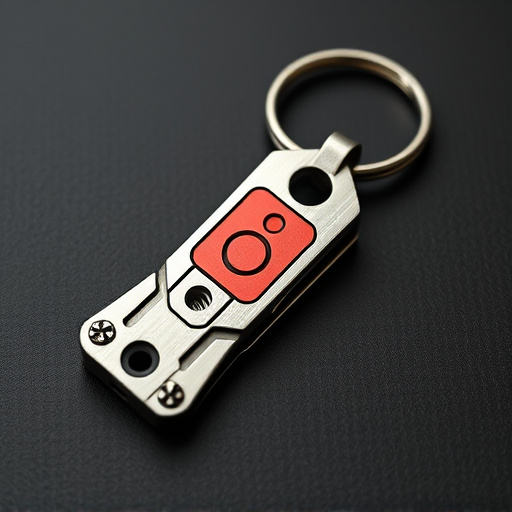Students considering legal keychain weapons for self-defense must research local laws regarding blade length and intended use. When designing a metal defense keychain, balance aesthetics with functionality, focusing on sharp edges, compact size, and ergonomic grip. Prioritize robust security features like reliable locking mechanisms to prevent accidental access while ensuring compliance with regulations on acceptable keychain weapons.
“In today’s world, personal safety is paramount, especially for students. Understanding legal keychain weapons can empower individuals to protect themselves effectively. This article explores the art of crafting metal defense keychains, providing essential design tips for those seeking self-defense tools. From choosing the right materials and ergonomic considerations to integrating advanced security features, we guide you through the process of creating a compact yet potent defense mechanism suitable for students carrying legal keychain weapons.”
- Understanding Legal Keychain Weapons for Students
- Choosing the Right Metal Defense Keychain Design
- Ergonomics: Comfort and Control for Self-Defense
- Security Features to Enhance Your Keychain's Effectiveness
Understanding Legal Keychain Weapons for Students
For students considering self-defense options, understanding the legal aspects of keychain weapons is paramount. It’s crucial to know that what may seem like a convenient defense tool could be subject to stringent regulations depending on your location. Many regions have specific laws governing the use and carrying of small, easily concealable weapons, often referred to as Legal Keychain Weapons for Students. These regulations vary widely from place to place, so it’s essential to research and understand the legal framework in your area before making a purchase.
Students should be aware that some keychains are designed primarily as promotional items or accessories and may not meet the criteria for legal defense weapons. The distinction between a legally compliant self-defense tool and an ordinary accessory can be subtle, often hinging on factors like blade length, material, and intended use. Staying informed about these details ensures students remain within the boundaries of the law while equipping themselves with what they perceive as necessary protection.
Choosing the Right Metal Defense Keychain Design
When designing a metal defense keychain, selecting the appropriate aesthetic and functionality is paramount. For students looking to carry legal keychain weapons for self-defense, balance is key. Opt for designs that combine sturdy construction with discreetness, ensuring it remains a functional accessory rather than a distraction. The right keychain should blend seamlessly into everyday life, easily carried in pockets or attached to bags without drawing undue attention.
Consider the purpose: self-defense in potentially dangerous situations. This means choosing materials and mechanisms that offer reliable strength and ease of use. A well-designed metal keychain should boast sharp, durable edges for effective defense without compromising portability. Remember, the goal is to have a compact, versatile tool that students can confidently rely on when needed while adhering to legal guidelines regarding keychain weapons.
Ergonomics: Comfort and Control for Self-Defense
When designing a metal defense keychain grip, ergonomics play a vital role in ensuring comfort and control during self-defense situations. The keychain should fit snugly in your hand, allowing for easy and swift access to the weapon while reducing strain on your grip. This is especially important for students carrying legal keychain weapons as it enhances their ability to defend themselves effectively.
A well-ergonomic design considers factors like grip width, weight distribution, and material texture. Wider grips offer better control but may increase hand fatigue over time, whereas narrower grips are more maneuverable but demand precise finger placement. Balancing these elements ensures the keychain feels comfortable in various gripping positions, enabling users to draw it promptly without compromising their hold during intense scenarios.
Security Features to Enhance Your Keychain's Effectiveness
When designing a metal defense keychain, security features are paramount to ensure its effectiveness as a legal keychain weapon for students. Incorporate sharp, robust edges that can be easily manipulated yet difficult to deactivate. A solid, unyielding construction prevents accidental unlocking and ensures the keychain remains a reliable tool in stressful situations. Additionally, consider adding a tactical grip pattern to enhance control and reduce slipping during use.
Integrating a secure locking mechanism is crucial for any defense keychain. Opt for a robust design that requires a specific sequence or physical action to open, deterring casual usage but making it readily available when needed. Remember, the goal is to provide students with a legal, convenient self-defense option while adhering to relevant regulations on acceptable keychain weapons.
When it comes to self-defense keychains, understanding both legal considerations and ergonomic design is crucial. By selecting a well-designed metal keychain with thoughtful features like comfort grip and robust security, students can ensure they have a reliable tool for their safety. Remember, the right keychain weapon can be a game changer in navigating potentially dangerous situations, providing peace of mind and the confidence to protect yourself.
